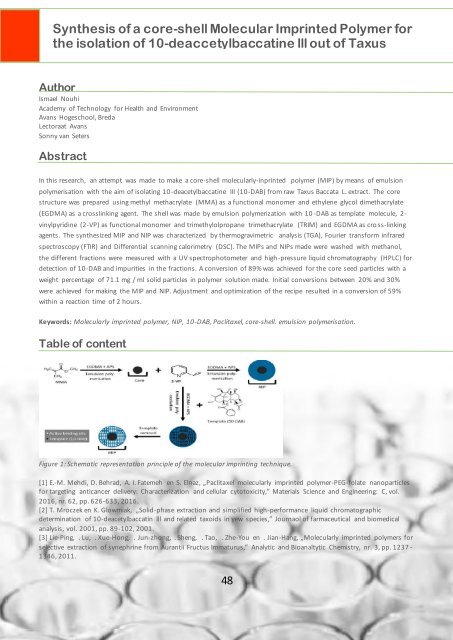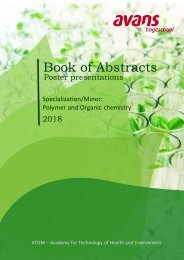Book of abstracts version 5
You also want an ePaper? Increase the reach of your titles
YUMPU automatically turns print PDFs into web optimized ePapers that Google loves.
Synthesis <strong>of</strong> a core-shell Molecular Imprinted Polymer for<br />
the isolation <strong>of</strong> 10-deaccetylbaccatine lll out <strong>of</strong> Taxus<br />
10-DAB<br />
Author<br />
Ismael Nouhi<br />
Academy <strong>of</strong> Technology for Health and Environment<br />
Avans Hogeschool, Breda<br />
Lectoraat Avans<br />
Sonny van Seters<br />
Abstract<br />
In this research, an attempt was made to make a core-shell molecularly-inprinted polymer (MIP) by means <strong>of</strong> emulsion<br />
polymerisation with the aim <strong>of</strong> isolating 10-deacetylbaccatine III (10-DAB) from raw Taxus Baccata L. extract. The core<br />
structure was prepared using methyl methacrylate (MMA) as a functional monomer and ethylene glycol dimethacrylate<br />
(EGDMA) as a crosslinking agent. The shell was made by emulsion polymerization with 10 -DAB as template molecule, 2-<br />
vinylpyridine (2-VP) as functional monomer and trimethylolpropane trimethacrylate (TRIM) and EGDMA as cro ss-linking<br />
agents. The synthesized MIP and NIP was characterized by thermogravimetric analysis (TGA), Fourier transform infrared<br />
spectroscopy (FTIR) and Differential scanning calorimetry (DSC). The MIPs and NIPs made were washed with methanol,<br />
the different fractions were measured with a UV spectrophotometer and high -pressure liquid chromatography (HPLC) for<br />
detection <strong>of</strong> 10-DAB and impurities in the fractions. A con<strong>version</strong> <strong>of</strong> 89% was achieved for the core seed particles with a<br />
weight percentage <strong>of</strong> 71.1 mg / ml solid particles in polymer solution made. Initial con<strong>version</strong>s between 20% and 30%<br />
were achieved for making the MIP and NIP. Adjustment and optimization <strong>of</strong> the recipe resulted in a con<strong>version</strong> <strong>of</strong> 59%<br />
within a reaction time <strong>of</strong> 2 hours.<br />
Keywords: Molecularly imprinted polymer, NIP, 10-DAB, Paclitaxel, core-shell. emulsion polymerisation.<br />
Table <strong>of</strong> content<br />
Figure 1: Schematic representation principle <strong>of</strong> the molecular imprinting technique.<br />
[1] E.-M. Mehdi, D. Behrad, A. I. Fatemeh en S. Elnaz, „Paclitaxel molecularly imprinted polymer-PEG-folate nanoparticles<br />
for targeting anticancer delivery: Characterization and cellular cytotoxicity,” Materials Science and Engineering: C, vol.<br />
2016, nr. 62, pp. 626-633, 2016.<br />
[2] T. Mroczek en K. Glowmiak, „Solid-phase extraction and simplified high-performance liquid chromatographic<br />
determination <strong>of</strong> 10-deacetylbaccatin lll and related taxoids in yew species,” Journaol <strong>of</strong> farmaceutical and biomedical<br />
analysis, vol. 2001, pp. 89-102, 2001.<br />
[3] Lie-Ping, . Lu, . Xue-Hong, . Jun-zhong, . Sheng, . Tao, . Zhe-You en . Jian-Hang, „Molecularly imprinted polymers for<br />
selective extraction <strong>of</strong> synephrine from Aurantii Fructus Immaturus,” Analytic and Bioanaltytic Chemistry, nr. 3, pp. 1237 -<br />
1346, 2011.<br />
48









